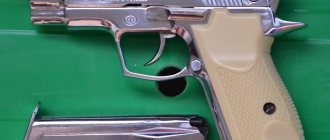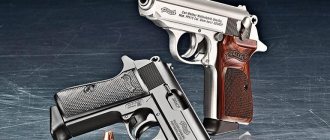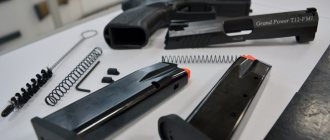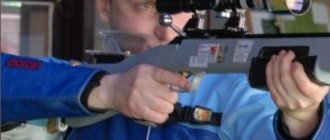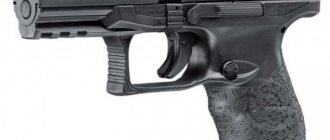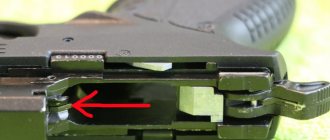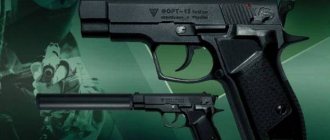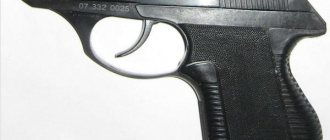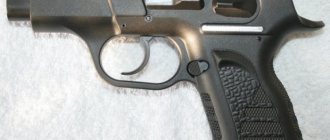At the end of the 90s, the first locally developed personal weapons were developed, launched into mass production and adopted in Ukraine. It “inherited” the name from the developer – the state scientific and production association “Fort”.
For more than 20 years, these Ukrainian pistols - from the basic model "12" to the latest version "17" and the traumatic "Fort-12RM" - have been mass produced and are in service with some countries. Traumatic weapons of this design have even become widespread in Russia. The plant in Klimovsk produced non-lethal weapons under a Ukrainian license for some time.
TTX fort 12 — Bing
results: 167,000,000Date Language Region
- https://ru.wikipedia.org/wiki/Fort-12
The pistol was developed in the early 1990s by NPO Fort by order of the Ministry of Internal Affairs of Ukraine due to the moral and physical obsolescence of Soviet Makarov pistols in service. The experience of the Czech arms company Ceská Zbrojovka was used during the development. The first experimental batch of Fort-12 pistols was manufactured in May 1995. In 1997, testing and trial operation of Fort-12 pistols were completed, in June 19...Wikipedia · Text licensed under CC-BY-SA
- https://www.armoury-online.ru/articles/pistols/ukraine/Fort-12
Fort-12 is produced in several finishing versions. The standard coating option is matte gray phosphating, as well as chrome plating, nickel plating, combined finishing and artistic inlay with engraving. - https://ru.wikipedia.org/wiki/Fort-17
"Fort-17" is a modification of the "Fort-12" pistol with a polymer frame made of glass-fiber reinforced impact-resistant polyamide, a detachable pad on the handle (allowing adjustment to the shooter's hand) and a Picatinny mount under the pistol barrel. The use of polymers has made it possible to reduce weight, increase manufacturability and reduce the cost of pistol production.Wikipedia · Text licensed under CC-BY-SA
- https://militaryarms.ru/oruzhie/travmaticheskoe/fort-12
The Fort 12 traumatic pistol is very popular. History of creation, performance characteristics and interesting facts. What are its main advantages, for which many consumers love it so much? - https://warways.ru/ognestrelnoe-oruzhie/travmaticheskoe-oruzhie/fort-12.html
One of the variants of “Fort 12” - “Fort 12 R”, manufactured in 1999, which is also intended for arming Ukrainian police, has, in Unlike … - Other images: TTX Fort 12
- www.fort.vn.ua/ru/8-fort-17
The Fort-17 pistol of 9 mm Makarov caliber has become a modern modification of the Fort-12 pistol. - www.fort.vn.ua/3-fort-12rm
Pistol “Fort-12” caliber 9 mm Makarov has already become a classic in its category. The pistol has a completely metal construction and is quite important compared to current “plastic” models of a similar caliber... - www.travmatik.com/2009/11/travmaticheskij-pistolet-fort-12r
The Fort-12R pistol has been produced since 1999 by KNPO Fort of the Ministry of Internal Affairs of Ukraine (Vinnitsa), an enterprise whose main specialization is the production of firearms and various special equipment for employees... - https://www.ukrmilitary.com/2015/10/fort-12.html
9-mm pistol “Fort-12” is a self-loading pistol chambered for 9x18 mm Makarov, also available for chambered 9x17 mm Browning Short (Kurz, .380 ACP). Virobnik: NVO "Fort" (Kazenne scientific-virobniche ob'ednannya "Fort" of the Ministry of Military Affairs of Ukraine).
Weapon
Shooting gallery Voronezh
The Fort Research and Production Association is a leading state-owned enterprise in Ukraine, engaged in the development and production of various types of firearms.
NPO "Fort" was founded on January 24, 1991, as a state-owned small scientific and production specialized enterprise. It was supposed to develop and introduce into production protective equipment for employees of the Ministry of Internal Affairs. The special department of the Department of Internal Affairs of the Vinnytsia region, which was engaged in the production of special means, became the platform for a new enterprise.
In 1994, in order to increase the enterprise’s capabilities for the development and production of domestic weapons and special equipment, it was decided to transfer the Vinnytsia Instrument Making Plant to the enterprise. This is how the NPP “Fort” of the Ministry of Internal Affairs of Ukraine was created.
In 1998, the Cabinet of Ministers of Ukraine made a decision to assign “Fort” state status. In the same year, production of the Fort-12 pistol began. The pistol is made on the basis of the Czech pistols CZ-83 and CZ-75. For this purpose, the necessary equipment was brought from the Czech Republic.
In March 1998, a workshop for the serial production of short-barreled weapons was opened. In October 2000, the company agreed with Uzbekistan on the supply of pistols.
In 2002, Fort launched the production of barrels using electroslag remelting technology. (Before this, the barrels were purchased from Ceska Zbrojovka).
Since 2003, Fort has begun to move into world markets. In 2004, the volume of pistols sold was 500 units.
All Athens police at the 2004 Olympic Games were armed with rubber batons and handcuffs manufactured by Fort.
On October 26, 2010, Prime Minister Mykola Yanovich Azarov visited the enterprise and said that a permanent state order for weapons and special equipment was possible, and also clarified that Fort had good development prospects.
On October 27, 2010, the Cabinet of Ministers of Ukraine donated 19.3 million hryvnia (about 60 million rubles) to Fort for the acquisition of a production line for weapons parts using the technology of injection formation of metal powders.
On July 8, 2011, the Ministry of Internal Affairs of Ukraine entered into a contract with Fort for the purchase of 336 firearms. (164 Fort-21 pistols and 54 silencers for them; 100 Fort-17-05 pistols with cases; 51 Fort-224 machine guns and 27 silencers for them; 7 Fort-221 machine guns; 7 Fort-401 machine guns and so on same as Fort-500 shotguns). This contract was worth 6.23 million hryvnia (25 million rubles).
In April 2012, PJSC Ukrhydroenergo purchased 118 Fort-17 pistols for its paramilitary security for the amount of 326 thousand hryvnia (approximately 1.325 million rubles).
At the moment, the company employs more than 600 specialists; production takes place using modern equipment and modern technologies. NPO Fort works in several directions, the main one being the development of high technologies for the production of small arms. Namely: software for calculating ballistics, computer registration of objects, methods of chemical-thermal treatment of parts, with the help of which Forta products can be used in various climatic conditions.
The only place in Ukraine where small arms are produced more or less en masse is the pistol production workshop. The main product is self-loading pistols of the Fort brand. They differ in caliber, barrel length and magazine capacity.
In addition to cartridges and military weapons, the lion's share of products are weapons for sports and hunting and traumatic samples.
Fort also established joint production with Israel under an Israeli license. 60% of parts for pistols are produced in Ukraine, another 40% are imported from Israel. In addition, production of Fort-221, Fort-222, Fort-223 and Fort-224 assault rifles based on the Israeli TAR-21 rifle is underway.
A significant part of the Fort's products is exported. The CIS countries are the main buyers of Fort's products; there were also deliveries to Asian countries. The state order is only 3-5%. Most often these are pistols for the State Tax Service, State Border Guard Service, SBU and the Ministry of Internal Affairs.
Modifications
- Fort-12 is a basic pistol.
- Fort-12 Curz - disassembled for shooting with 9×17 Kurz cartridges.
- Fort-12B is a pistol with a flexible barrel. It allows you to purchase a kit that includes an additional barrel with a thread on the muzzle and a device to reduce the sound of the shot. This threat has already begun to establish itself among the fighters of special forces.
- Fort-12G - modification is intended for firing gas (PA BLANK) and noise (PAK) cartridges of 9 mm caliber, as well as launching signal flares using an additional blank cartridge of the same caliber 9 mm.
- Fort-12R - disassembled for firing 9-mm traumatic cartridges of the R.A. type, with non-lethal elastic bullets. Used for the civilian population and for the funeral service. The effective firing range is 10 m.
- Fort-12RM is also designed for firing 9-mm traumatic cartridges of the R.A. type or 11.43-mm .45 Rubber type, equipped with non-lethal elastic bullets. Used for the civilian population and for the funeral service. The effective range is 10 m. It looks like Fort-12R with improved ergonomics.
- Fort-12T is a gas pistol with the ability to fire traumatic cartridges of 9 mm caliber R.A. A design feature of the pistol is the presence of partitions in the barrel bore.
- Sokil is a sporting pistol, developed on the basis of the Fort-12 combat pistol, equipped with adjustable sighting devices and a device for extinguishing fire and meets all the requirements of the International Confederation of Practical Shooting.
Positive sides
So what distinguishes the model from its analogues, and primarily from its competitor, Fort-12R? If the Fort-17R is slightly inferior in terms of strength, its weight is much less. Namely, this feature is one of the most important in traumatic pistols. Carrying a large, heavy weapon every day can never be enjoyable. The ergonomic handle and convenient arrangement of elements on the gun are also a plus of the model. However, you need to get used to this, especially for those who have already had experience in using traumatic weapons.
Removing the pistol from the safety can be done with the thumb, which speeds up the time that is involuntarily spent on firing. The bolt release lever and the magazine release button are also within direct access. It is worth noting that the handle size can be changed. However, this requires back parts, and they are not included in the kit. You can also change the front and rear sights to ones that are more convenient for a particular person. And the bar allows you to install a laser sight or flashlight. In general, Fort-17R is an excellent model that is common in many countries. It is reliable and easy to use. The Fort pistol is capable of saving a person’s life and not letting him down in times of danger. Its price is about 20,000 rubles.
9-mm pistol "Fort-12"
07.10.15
9-mm pistol "Fort-12"
– a self-loading pistol for 9x18 mm Makarov, also available for 9x17 mm Browning Short (Kurz, .380 ACP).
Virobnik:
NVO "Fort" (Kazenne scientific-virological association "Fort" of the Ministry of Internal Affairs of Ukraine).
Rozroblennya 1995-1998, virobnitstvo since 1998.
The pistol is automatic, trigger-type, with a magazine feed of cartridges, intended for firing single shots. Automatic reloading of the pistol is driven by the energy consumption of powder gases that are created during shooting. The closing of the chamber is ensured by the force of the gate spring and the weight of the bolt when the bolt is not engaged with the barrel.
It has a completely metal construction and is considered quite important in comparison with current “plastic” models of a similar caliber, but this power can be secured to the active pistol, the remains of the metal construction with It is durable in use and resistant to shooting. The pistol can be equipped with a device to reduce the level of shooting sound.
Modifications
- Fort-12B
– pistol with a flexible barrel - Fort-12G
- for firing 9-mm gas (PA Blank) and noise (PAK) cartridges and launching signal flares using an additional blank cartridge - Fort-12R
is a traumatic pistol of 9 mm R.A. caliber. (.45 Rubber) - Fort-12RM
– Fort-12R with improved ergonomics and changed bolt shape - Fort-12T
- gas, with the ability to fire traumatic 9-mm RA cartridges. (.45 Rubber) - Fort-17
- modification with vikoristan polymer is now easier
Tactical and technical characteristics
| Caliber, mm: | 9x18 / 9x17 |
| Principle: | free shutter |
| Trigger mechanism: | single and double action |
| Zagalna dovzhina, mm: | 180 |
| Height, mm: | 131 |
| Width, mm: | 33 |
| Barrel length, mm: | 95 |
| Cart with empty magazine, kg: | 0,83 |
| Store capacity, cartridges: | 15 (9x18 mm) / 16 (9x17 mm) |
| Zusilla descent, kgf: | 2,0-3,5 |
| Pochatkova fluidity of weed beds, m/s: | 320 (9x18 mm) / 305 (9x17 mm) |
| Practical quick-shooting, post-fire/xv.: | 40 |
| Sighting range, m: | 25 |
| Narizi: | 6 |
Main parts of the gun
(click on images for extra value)
All photos and images: NVO “Fort”
On ozbroenni (vikoristannya)
Acceptance for registration by the Ministry of Internal Affairs, Security Service of Ukraine.
Vikoristani dzherela:
Website of the State Research and Development Association “Fort” of the Ministry of Internal Affairs of Ukraine
Disassembly and assembly
Fort-12 on the slide stop
Fort 12 incomplete disassembly
Fort-12R, magazine removed
To perform partial disassembly of the Fort-12 pistol, you must:
- Make sure the weapon is unloaded. To do this, you need to remove the magazine, pull the bolt back and inspect the chamber.
- Use a magazine or cleaning rod to press the bolt stop axis on the right side.
- Separate the bolt stop by pulling it from the left side.
- Separate the shutter. To do this, move the bolt to its rearmost position, lift its rear end and move it forward, removing it from the barrel.
- Pull out the return spring and its guide.
The pistol is reassembled in the reverse order. After assembly it is necessary to inspect:
- Pull the trigger, turn on the safety. The bolt, hammer and trigger must be locked.
- Turn off the safety, cock the hammer, turn on the safety. The bolt, hammer and trigger must be locked.
- Turn off the fuse and perform an idle descent.
- Insert the magazine, check the reliability of its fixation.
Conclusion
The Fort-12RM turned out to be an excellent traumatic weapon, which inherited the best qualities and characteristics from its combat ancestor. It can be safely used as the main weapon for reliable civilian self-defense. It has excellent power, good magazine capacity and high reliability, which provides a large supply of working life.
It is worth noting that Fort-12 is suitable not only for good self-defense, but it can also be used for recreational or sports shooting. However, we must not forget that, like any other traumatic weapon, this weapon requires regular cleaning of all its parts, especially those that bear the greatest load when firing.
[edit] Comparison with foreign analogues
The table shows comparative tactical and technical characteristics of the Fort-12 pistol with its analogues CZ-75 and CZ-83, as well as with the Yarygin pistol, which was adopted by Russian security forces in 2003-2008.
| Pistols | Fort-12 | CZ-75 | CZ-83 | Yarygin pistol |
| USM | Double action | Double action | Double action | Double action |
| Caliber | 9 mm | 9 mm | 9 mm | 9 mm |
| Ammunition type | 9×18 mm PM | 9x19mm Parabellum | 9x19mm Parabellum | 9x19mm Parabellum |
| Number of rifling | 6 grooves | n/a | n/a | n/a |
| Weight of weapons with an empty magazine | 830 g | 1000 g | n/a | 950 g |
| Weight with loaded magazine | 950 g | n/a | 920 g | n/a |
| Weapon length | 180 mm | 206 mm | 172 mm | 198 mm |
| Barrel length | 95 mm | 120 mm | 96 mm | 112 mm |
| Ammunition | 12 rounds | 16 rounds | 12 rounds | 17 rounds |
| Initial bullet speed | 315 m/s | n/a | n/a | 450 m/s |
| Effective range | 350 m | 350 m | 350 m | 350 m |
| Combat rate of fire | 40 rounds per minute | n/a | n/a | n/a |
[edit] Purpose of USM parts
- Trigger - used to strike the firing pin.
- A sear with a spring - used to hold the trigger on the combat and safety cock.
- Trigger and trigger rod - used to release the hammer from cocking and cocking the hammer when the tail of the trigger is pressed.
- Mainspring - serves to provide the trigger with the energy necessary to strike the firing pin.
- Lever - used to operate the trigger.
- Stop - serves to hold the mainspring and lever.
- Separator - serves to prevent a shot when the bolt is unlocked.
- Reflector - serves to reflect the cartridge case or cartridge while the bolt moves backward.
Pistol "Fort-12"
"Fort-12" is a Ukrainian semi-automatic self-loading pistol of 9x18 mm caliber, which is capable of effective shooting at a distance of up to 50 meters.
The Fort-12 pistol was developed in the early 1990s at the Vinnitsa Armory. The appearance of this weapon was provoked by the fact that the weapons of the Ukrainian special forces in those days were very outdated. The main weapon of the Ministry of Internal Affairs then was the Soviet Makarov pistol. "Fort-12" was created taking into account the experience of the Czech arms company Ceská Zbrojovka.
The first batch of these pistols was released in May 1995. At first, equipment from the Czech Republic was used in production. The first batches of Fort-12 pistols were distinguished by their high labor and material-intensive manufacturing, they did not have a swivel, and were characterized by low strength of the firing pin and the bolt stop axis.
As for the design of the Fort-12, this weapon is completely (except for the lining on the handle) made of weapons-grade steel. This significantly increases the strength of the pistol. The basic principle of operation is the recoil of the free shutter.
The trigger mechanism of the Fort-12 pistol itself is designed on the basis of the trigger mechanisms of the CZ-75 and CZ-83 pistols. This design allows you to shoot both self-cocking and from a pre-cocked hammer.
The pistol barrel is made using the burnishing method and has 6 grooves in the channel. The disadvantage is that the gun barrel itself is not chrome-plated, which can cause corrosion.
The safety lever is located on the left side of the bolt; it blocks the bolt, sear, trigger, hammer and trigger. The pistol magazine is designed on a two-row principle. The magazine latch is located near the base of the trigger guard; if all the cartridges are used up, the Fort-12 pistol becomes locked. This allows you to avoid spending a lot of time recharging.
The rear sight and front sight have fluorescent round marks, which provides ease of aiming in conditions with insufficient visibility.
The Fort-12 differs from the Makarov pistol in better ergonomics, higher shooting accuracy and a higher rate of fire. Many experts consider the reflector to be a disadvantage, which supposedly needs to be shortened to prevent its deformation and the shutter wedge.
| Combat characteristics | Pistol "Fort-12" |
| Gun length | 180 mm |
| Barrel length | 95 mm |
| Height | 131 mm |
| Width | 33 mm |
| Mass with empty magazine | 0.83 kg |
| Weight with loaded magazine | 0.95 kg |
| Initial bullet speed | 320 m/s |
| Rate of fire | 40 rounds per minute |
| Number of rifling | 6 grooves |
The developers never stopped improving the Fort-12 pistol, as a result of which various modifications of this model appeared:
— “Fort-12B” (silent pistol, equipped with a removable elongated barrel and a removable silencer),— “Fort-12N” (award version of the weapon),— “Falcon” (sporting version of the pistol with an elongated barrel),— “Fort-12 CURZ” "(version chambered for 9x17 mm K.)— "Fort-12G" (gas model of a pistol chambered for 9 mm R.A.K. cartridge, the production of these pistols has already been discontinued),— "Fort-12RM" (traumatic pistol),— "Fort-12T" (civilian traumatic pistol),
— “Fort-17” (modification of 2004, which is equipped with a polymer frame and mount for installing a laser target designator).
In 1998, the Fort-12 pistol was adopted by the police and internal troops of Ukraine. In 2000, in Yugoslavia, soldiers of the special canine unit of the Ministry of Internal Affairs of Ukraine were armed with these pistols (before being sent to the Ukrainian UN peacekeeping contingent). As of 2004, 12% of the personnel of the Ministry of Internal Affairs of Ukraine were armed with Fort-12 pistols.
History of creation
After 1991, the army and police of independent Ukraine were left with a single service and combat pistol - the PM. This weapon has not satisfied users for a long time, but before the collapse of the USSR, a replacement was never found.
Even during the existence of the Soviet Union, a special department of the Internal Affairs Directorate was located in Vinnitsa, producing “special equipment”. At the beginning of 1991, it was reorganized into the Fort research and production association.
In 1994, an instrument-making plant was placed at the disposal of this NGO.
From this moment we can count down the creation of the first Ukrainian combat pistol “Fort”. To assist in development, contacts were established with the Czech company CZ. Equipment for the production of weapons was received from the Czech Republic, and serial production began in 1998.
Options and modifications
- Fort-12B
is a silent pistol chambered for 9×18 mm PM, a modification with a removable extended barrel and a removable silencer (the so-called “Fort-4” kit). - Fort-12N
is an award version of the pistol, produced since 1995; by the end of 2016, 140 award pistols of this type were awarded - “Falcon”
is a sports pistol chambered for 9x18 mm PM, with a barrel extended to 107.5 mm (due to the installation of a muzzle brake-compensator) and an adjustable rear sight, optimized to IPSC requirements. Out of production - Fort-12 CURZ
- modification chambered for 9×17 mm K cartridge. - Fort-12G
is a gas pistol chambered for the 9 mm PAK cartridge. (production discontinued) - Fort-12R
is a traumatic pistol (service model) chambered for 9 mm RA cartridge, has a smooth barrel without rifling, intended for law enforcement officers. Produced since 1999. According to the manufacturer, the pistol's lifespan is 50 thousand shots. - Fort-12T
is a traumatic pistol (civilian model) chambered for 9 mm R.A. cartridge, has a barrel with protrusions on the inner surface that do not allow these pistols to fire an inelastic bullet. - Fort-17
- modification of 2004 with a polymer frame made of fiberglass-reinforced impact-resistant polyamide, a detachable pad on the handle (allowing adjustment to the shooter’s hand) and a mount for installing a laser target designator. The design of the mechanisms is identical to the Fort-12 pistol, but lighter (680 g) and cheaper to manufacture.
Also, from 2006 to 2014, in the city of Klimovsk (Russian Federation), traumatic pistols of the “Fort” series were assembled from Ukrainian components under the names “Jorge” (“Fort-12T”) and “Jorge-S” (“Fort-12R”).
Traumatic revolvers
The next most complex type of non-lethal self-defense weapon is revolvers. This type of “injury” is unpretentious in use and maintenance, but at the same time very effective - such revolvers often look like real combat models, and one type of weapon removed from a holster can lead the aggressor into a state of extreme confusion.
"Storm"
The Groza family of revolvers produced are high-quality and reliable samples, equipped with a double-action trigger mechanism. The frame is made of high quality steel, and alloy options are also possible. All models are produced under the 9 mm RA cartridge and outwardly look identical to combat models. The only drawback of this series of revolvers is the low power of the shot, although it is quite capable of stopping an aggressor.
"Viking"
This revolver is an exact copy of the Smith & Wesson Chief Special and is as reliable as its military brother. The revolver is distinguished by good performance, a comfortable grip and light weight, but it has low stopping power - the muzzle energy of the cartridge is recorded at around 37 J. This is partly the fault of the short barrel with too often spaced bulges to slow down the rubber bullet, and partly due to the weak .380 GUM ammunition. Also, due to the short barrel, there is quite a strong scatter at distances from 5 meters. On the other hand, the shooting distance for self-defense rarely reaches even five meters, so I personally do not consider this drawback to be significant.
"Nagan M"
The only former Nagan combat revolver in our rating, which through deep processing was transferred to the category of traumatic. "Nagan M" uses a 10x23 mm traumatic cartridge - frankly speaking, rather weak by today's standards. There is also a very tight trigger of the revolver when firing by self-cocking. At the moment, production of this model has been discontinued, but a few copies are still available for sale. As a self-defense weapon, the Nagan M will be somewhat inconvenient, but will serve well as an element of historical heritage.
"Ratnik 410x45TK"
An excellent traumatic action revolver, developed on the basis of the well-proven “Udar” revolver, but chambered for the new 410x45 Rubber cartridge. This cartridge has two 16-mm rubber bullets, the muzzle energy of which is sufficient to disable it with one shot. This is partly facilitated by the smooth barrel - it does not have any narrowing or sagging characteristic of a traumatic weapon. The disadvantages of this revolver are its relatively large dimensions (thickness reaches 44 mm), as well as the unstable coating of the weapon - it begins to peel off almost after the first shots.
Notes
- ↑ (pdf). (unavailable link)
- ↑
- Mikhail Trushechkin. Ten years is a long time! Traumatic weapons - results and prospects (part 2) // “Master Gun” magazine, No. 8 (137), August 2008. pp. 60-64
- “ The production has been launched and a large number of Fort-12 pistols have already been manufactured for firing gas cartridges, Fort-12R - ammunition filled with a rubber or plastic bullet with a traumatic effect.
A large batch of these weapons was purchased by customs office Vera Valerko. Excise tax on a stick “Armament with the mark “Made in Ukraine” // weekly “2000”, No. 22 (23) from June 2-8, 2000 - In Ukraine // magazine “Master Gun”, No. 69, December 2002. p.4
- Order of the Administration of the State Cordon Service of Ukraine No. 170 dated March 13, 2012 “On the approval of the Instructions on the organization of security will improve access control in the Administration of the State Cordon Service of Ukraine neither"
- Organization of fire training for prosecutors to ensure special security: beginning - practice. pos_b. / . – K.: National Academy of Prosecutor's Office of Ukraine, 2016. page 28-29
- “ The subject of security activities has the right: to ensure security activities, add, save and use, in accordance with the procedure established by law, special features, the transfer of which is designated by the Cabinet of Ministers of Ukraine
“Law Ukraine No. 4616-VI dated 22 February 2012 “About security activities” - Resolution of the Cabinet of Ministers of Ukraine No. 97 dated February 11, 2013. “About the confirmation of the transfer of special services, the preparation, preservation and use of which are affected by the subjects of security activity”
- “ As reported to “Segodnya” by the Central Investigation Department of the Ministry of Internal Affairs of Ukraine in the Lvov region, the suspect in this crime has been identified - this is 39-year-old S., a correspondent for one of the local newspapers.
A registered 9 mm caliber Fort-12R pistol, adapted for firing rubber bullets, was confiscated from him. Interestingly, several years ago the Lviv police handed similar pistols to media representatives on the occasion of Journalist Day “The newspaperman threatened with a pistol // Segodnya newspaper, No. 138 (1483) dated June 24, 2003 - Order of the Ministry of Ecology and Natural Resources of Ukraine No. 29 dated 02/17/2015. “An overview of the quality of work and special features that are offered to the workers of the State Protection Service of the Natural Reserve Fund of Ukraine”
- Fort-12R, Fort-12RM, Fort-12T, Fort-14R, Fort-17R, Fort-17T, Fort-18R // Precision guided weapons, small arms, light weapons and self-protection equipment. Spetstechnoexport catalog 2022. page 44
Volleyball betting with points handicap
Shark traumatic pistol
To settle bets on a volleyball match with a point handicap, in which Team 1 and Team 2 are participating, you must:
1. Determine the number of points scored by each team.
For example, let's say that a volleyball match ended in victory for Team 1 with a game score of 3:1, while the points for each game were: 25:21, 24:26, 25:18, 25:22. Thus, the total points score will be 99 (25+24+25+25) : 87 (21+26+18+22), i.e. Team 1 scored 99 points, and Team 2 scored 87 points.
2. Determine the handicap score (taking into account the handicap) by points. To do this, you need to add (if the handicap is positive) or subtract (if the handicap is negative) the number of handicap points from the number of points of the team on which the bet is made with a point handicap. At the same time, the number of points of the other team remains unchanged. Based on the result obtained in this way, it is determined whether the bet with a points handicap won or lost.
Let's say a bet was made with a handicap of -11.5 on Team 1 (H1(-11.5)) with odds of 1.9. To calculate such a bet, it is necessary to subtract the handicap value from the total number of Team 1 points: 99 (number of Team 1 points) – 11.5 (handicap) = 87.5. Those. the number of points of Team 1 according to the calculation results taking into account the handicap was 87.5.
The number of Team 2 points (87) does not change.
Thus, according to the result of calculating the above bet with a handicap of -11.5, the final result is the score 87.5 : 87. And since Team 1 scored more points (in the example under consideration, by only 0.5), then the bet on it, taking into account the handicap -11.5, won and the player who makes such a bet will receive a win equal to the bet amount multiplied by the odds. So, with a bet of 1000 rubles. the winnings will be 1000 rubles. x 1.9 = 1900 rub.
Example 2.
Let’s assume that in the match discussed above, a bet was made taking into account the +15 handicap on Team 2 (T2(+15)). The calculation in this case will be as follows:
The handicap value is added to the number of Team 2 points: 87+15 = 102. I.e. the number of points for Team 2 based on the calculation results, taking into account the handicap, was 102.
The number of Team 1 points (99) does not change.
Thus, according to the result of calculating the above bet with a handicap, the final result is 99: 102. And since Team 2 scored more points (in the example under consideration, 3), then the bet on it, taking into account the handicap, won.
If the result calculated with a handicap turns out to be a draw, the bet amount will be returned to the player.
For example, let’s return once again to the match Team 1 – Team 2 discussed above, which ended with a points score of 99:87 in favor of Team 1.
Let's say a bet was made with a -12 handicap on Team 1 (H1(-12)). To calculate such a bet, it is necessary to subtract the handicap value from the total number of Team 1 points: 99 (number of Team 1 points) – 12 (handicap) = 87. Those. the number of points for Team 1 based on the calculation results, taking into account the handicap, was 87.
The number of Team 2 points (87) does not change.
Thus, according to the result of calculating the above bet with a handicap of -12, the final result of the match in question will be a draw (87: 87), i.e. According to calculations, taking into account the handicap, neither team won. And in this case, the bookmaker will return the bet amount to the player who made such a bet. In other words, a payment will be made with a coefficient equal to 1 (K=1).
